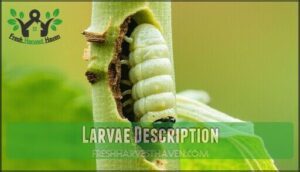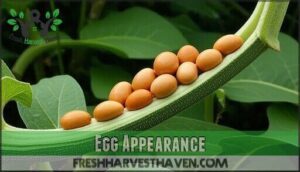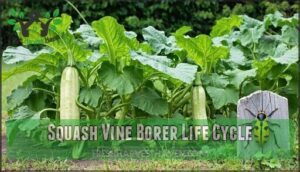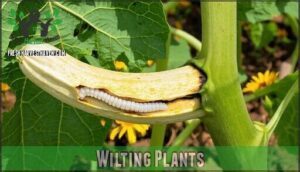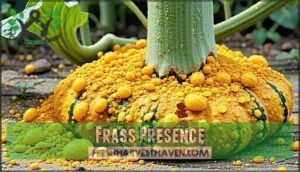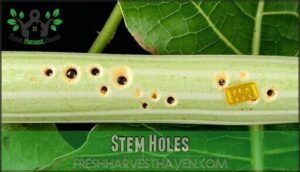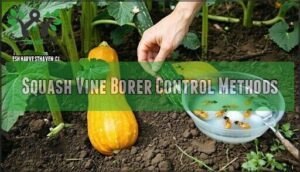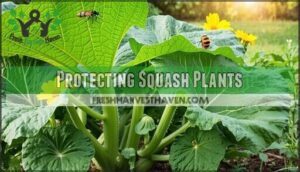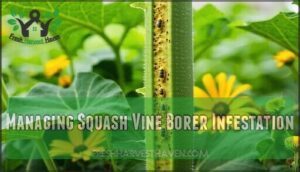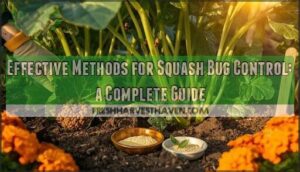This site is supported by our readers. We may earn a commission, at no cost to you, if you purchase through links.
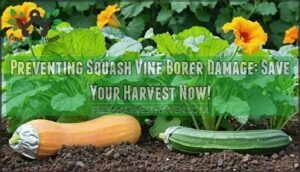
These clear-winged moths lay eggs at stem bases, where larvae tunnel inside and cause sudden wilting.
Wrap aluminum foil around the base of young stems as a physical barrier, rotate crops annually to disrupt their life cycle, and plant nasturtiums nearby as natural repellents.
Check plants weekly for telltale orange sawdust-like frass around stems—it’s your early warning system.
Timing is everything with these sneaky pests, and the right combination of barriers and plant choices creates multiple layers of defense that’ll keep your harvest intact.
Table Of Contents
- Key Takeaways
- Squash Vine Borer Basics
- Squash Vine Borer Identification
- Squash Vine Borer Life Cycle
- Squash Vine Borer Damage Signs
- Preventing Squash Vine Borers
- Squash Vine Borer Control Methods
- Protecting Squash Plants
- Squash Vine Borer Repellents
- Managing Squash Vine Borer Infestation
- Squash Vine Borer Prevention Tips
- Frequently Asked Questions (FAQs)
- uestion: How Do I Stop Squash Vine Borers?
- What deters squash vine borers?
- Do coffee grounds repel squash vine borers?
- What is the natural enemy of the squash vine borer?
- uestion: How Do I Stop Squash Vine Borers?
- Is Your Squash Plant Infested With These Squash Pests?
- How can beneficial insects help prevent borers?
- What time of year is squash planting safest?
- Are there natural traps effective against adult moths?
- Conclusion
Key Takeaways
- Install physical barriers early – Wrap aluminum foil around stem bases and use row covers during peak egg-laying season (early to mid-summer) to prevent moths from accessing your plants
- Choose resistant varieties – Plant butternut or delicata squash varieties that have solid stems naturally resistant to borer penetration, reducing damage by up to 90%
- Practice strategic companion planting – Plant nasturtiums, mint, and radishes near your squash to repel adult moths and disrupt their ability to locate plants for egg-laying
- Monitor weekly for early warning signs – Check stem bases regularly for orange sawdust-like frass and small entry holes, as early detection allows you to remove infested plants before borers spread to healthy ones
Squash Vine Borer Basics
Squash vine borers are sneaky pests that can destroy your entire squash harvest in just days, turning healthy plants into wilted disappointments.
These silent destroyers turn thriving gardens into graveyards overnight—strike first or lose everything.
Understanding their life cycle, identifying key warning signs, and recognizing damage symptoms will help you protect your garden before these destructive larvae strike.
Life Cycle Stages
Understanding the squash vine borer’s life cycle helps you time your defenses perfectly.
This pest follows a predictable pattern that you can exploit for garden protection.
- Egg Stage: Copper-colored eggs hatch after 7-10 days of incubation
- Larval Development: White grubs tunnel through stems for 2-4 weeks
- Pupal Formation: Larvae pupate in soil cocoons during winter months
- Adult Emergence: Moths appear in early summer for egglaying
- Overwintering: The pupal stage survives cold temperatures underground
Identification Methods
Visual inspection remains your first defense against squash vine borer infestations. Check stem bases for frass—sawdust-like debris indicating internal larvae activity.
| Detection Method | Key Indicators |
|---|---|
| Egg Detection | Tiny brown oval specks at stem bases |
| Stem Examination | Small entry holes with surrounding frass |
| Larvae Identification | White grubs with dark heads inside stems |
| Frass Analysis | Orange-yellow sawdust material near holes |
| Early Warning Signs | Sudden wilting despite adequate moisture |
Perform regular stem examinations, looking for entry holes and frass identification markers that signal vine borer damage before plant collapse occurs. Effective garden hygiene practices, including squash bug control, can also help prevent infestations.
Damage Symptoms
Spotting squash vine borer damage starts with recognizing sudden plant collapse despite adequate watering.
These destructive pests create telltale signs that help you identify infestations before total plant loss occurs.
- Wilting Plants: Healthy vines suddenly droop and collapse overnight
- Frass Signs: Orange-yellow sawdust appears around stem bases
- Stem Damage: Small entry holes reveal borer tunneling activity
- Plant Collapse: Entire sections wilt despite moist soil conditions
- Leaf Wilting: Individual leaves yellow and die from nutrient disruption
Squash Vine Borer Identification
You’ll need to recognize three key stages of squash vine borers to protect your plants effectively.
Identifying adult moths, larvae, and eggs before they cause damage gives you the best chance of saving your harvest.
Adult Moth Characteristics
Don’t let these sneaky moths fool you—they’re master mimics that resemble wasps with their orangey-red abdomens decorated with black dots and metallic greenish-black wings.
Adult Melittia cucurbitae moths exhibit distinctive wing patterns and coloration traits that make moth identification easier once you know what to look for.
Their adult behavior includes daytime activity, unlike many nocturnal moths, making them easier to spot during garden inspections.
Understanding the moth lifecycle helps you recognize when these pollinators transform from helpful visitors into egg-laying threats, depositing up to 200 eggs during their brief 3-5 day lifespan.
Larvae Description
Once you spot the telltale adult moths, you’ll need to watch for their destructive offspring.
Squash vine borer larvae appear as creamy-white worms with wrinkled bodies and distinctive black heads, growing up to one inch long during their larval development.
These destructive pests tunnel through plant stems for 4-6 weeks, creating internal damage that’s often invisible until it’s too late.
- Larvae Appearance: Look for white, segmented worms with dark heads inside affected stems
- Borer Behavior: They create tunnels that disrupt water flow throughout the plant
- Frass Identification: Watch for sawdust-like excrement near stem bases indicating active feeding
Egg Appearance
Recognizing squash vine borer eggs early gives you the upper hand against Melittia cucurbitae. These tiny copper-colored specks measure just 1mm, appearing as flattened oval discs with smooth texture.
Finding them requires checking stem bases where moths strategically deposit clusters.
| Egg Characteristic | Description |
|---|---|
| Size & Shape | 0.04 inches (1mm), flattened oval |
| Color & Texture | Reddish-brown copper, smooth surface |
| Location Pattern | Stem base clusters, leaf undersides |
| Timing Window | 7-10 days before hatching |
Squash Vine Borer Life Cycle
Understanding the squash vine borer’s life cycle is your key to stopping these destructive pests before they ruin your harvest.
These crafty insects follow a predictable annual pattern that you can exploit to protect your precious squash plants.
Overwintering Pupae
These tiny architects create underground shelters that’ll determine next year’s garden battle.
Squash vine borer pupae burrow 1-2 inches deep in soil, forming protective cocoons for winter survival. Understanding their pupal stage helps you disrupt this critical lifecycle phase.
Key overwintering pupae strategies:
- Soil Depth Management – Till garden beds 3-4 inches deep to expose buried cocoons to freezing temperatures and predators
- Pupae Formation Disruption – Remove plant debris where larvae might pupate, forcing them into less suitable locations
- Winter Survival Prevention – Apply beneficial nematodes in fall to target overwintering pupae before spring emergence
Egg Laying Process
Adult moths emerge in early summer with precise egg timing, targeting healthy squash plants through strategic moth behavior.
These sneaky insects demonstrate selective stem selection, choosing sturdy plant bases near soil level for ideal larval survival.
Each female deposits 150-200 tiny, reddish-brown eggs measuring just 1mm in egg size. Their laying habits involve systematic egg location placement over 3-5 days.
Understanding this squash vine borer reproductive cycle enables effective prevention methods like row covers and foil barriers, making vine borer prevention achievable through targeted intervention during peak laying periods.
Larval Feeding Habits
After eggs hatch within 7-10 days, squash vine borer larvae immediately begin their destructive larval feeding inside plant stems.
These white grubs with dark heads create stem damage by tunneling through vines for 4-6 weeks during larval development. Understanding their feeding patterns helps with borer control strategies.
Larval Behavior includes:
- Boring into stems within hours of hatching
- Creating orange-yellow frass (excrement) at entry holes
- Disrupting water and nutrient flow through tunneling
- Growing up to 1 inch long during feeding period
- Pupating in soil after completing stem destruction
Early larvae damage prevention and vine borer control depend on recognizing these feeding patterns before borer damage prevention becomes impossible. Effective summer squash care is essential for preventing such issues and promoting healthy plant growth.
Squash Vine Borer Damage Signs
Early detection of squash vine borer damage starts with recognizing the telltale signs that appear when larvae begin their destructive work inside your plants.
You’ll want to inspect your squash plants regularly for these key indicators, as catching an infestation early gives you the best chance to save your harvest.
This approach allows for early detection, which is crucial in preventing significant damage to your plants.
Wilting Plants
The telltale sign of squash vine borer infestation is plant decline through sudden wilting despite adequate moisture.
Your healthy plants mysteriously droop overnight as larvae create stem damage that disrupts water transport, causing leaf wilt.
This water loss occurs when borers tunnel through vascular tissue, making preventing borer damage essential.
Once wilting starts, vine borer control becomes difficult since squash plant care can’t reverse the internal destruction.
Frass Presence
Looking for orange-yellow frass around your squash plant’s base? You’ve spotted the squash vine borer signature.
This sawdust-like waste accumulates where larvae tunnel into stems, creating visible borer signs.
Fresh, moist frass indicates active stem damage is happening right now.
The more frass you discover, the worse your infestation has become—making immediate vine borer control essential for preventing borer damage.
Stem Holes
Small holes in your squash stems reveal where squash vine borer larvae have penetrated, creating entry points for stem damage and secondary infections. These openings typically appear near the base and compromise structural integrity.
Stem Protection requires immediate action when you spot these telltale signs. The following steps can be taken to protect the stems:
- Hole Repair – Cover small openings with grafting tape or aluminum foil
- Frass Removal – Clean sawdust-like debris from around entry points
- Borer Traps – Place yellow sticky traps near affected plants
- Natural Borer Control – Apply beneficial nematodes to soil around stems
Early detection of borer damage enables effective vine borer prevention strategies.
Preventing Squash Vine Borers
You can protect your squash plants from devastating vine borer damage by implementing proven prevention strategies before moths emerge in early summer.
The key is creating barriers and using resistant varieties rather than trying to treat infestations after they’ve already begun destroying your plants from the inside out.
Row Covers
Row covers act as your garden’s bodyguard against squash vine borers, blocking adult moths from reaching vulnerable plants. These barrier methods create an impenetrable shield during critical egg-laying periods, dramatically reducing infestation risk.
Garden fabric and floating row covers made from lightweight materials provide effective crop protection while maintaining proper airflow and light penetration.
- Install breathable materials early in the season before moth emergence
- Secure edges tightly with soil or clips to prevent gaps
- Remove temporarily during flowering for pollination, then reinstall immediately
Effective summer squash care is also essential in preventing damage to your plants.
Crop Rotation
Breaking the pest-cycle through strategic field placement, crop rotation disrupts squash vine borer development by relocating susceptible plants away from overwintering pupae.
You’ll eliminate their direct access to preferred hosts while improving soil health and reducing pest pressure naturally.
| Rotation Strategy | Implementation Timeline |
|---|---|
| Annual Field Changes | Move squash family 100+ feet |
| Soil Management | Till former locations deeply |
| Crop Planning | Use 3-4 year rotation cycles |
| Seasonal Shifts | Plant non-cucurbits between seasons |
| Farm Scheduling | Track previous planting locations |
This borer prevention method works because pupae remain dormant in soil for months, emerging exactly where last year’s infected plants grew, only to find their food source has vanished.
Resistant Varieties
Choose butternut squash and other Cucurbita moschata varieties as your strongest defense against vine borers.
These borer resistant squash types feature solid stems that prevent larval penetration, suffering 90% less damage than susceptible varieties.
Heirloom varieties like Seminole pumpkin and Tromboncino offer reliable protection, while Hubbard squash (Cucurbita maxima) provides moderate resistance for pest-resistant varieties in your garden.
For effective prevention, consider using resistant varieties to minimize damage from squash vine borers.
Squash Vine Borer Control Methods
Once you’ve spotted the telltale signs of squash vine borer damage, you’ll need proven control methods to stop these destructive larvae in their tracks.
These targeted strategies help eliminate existing borers and protect your remaining plants from further infestation.
Hand Picking
Manual Removal offers the most direct approach to vine borer control through systematic Garden Monitoring. This organic pest control method requires daily Pest Inspection of stem bases where you’ll spot telltale frass deposits.
Here’s your hand picking strategy for effective squash plant protection:
- Borer Trapping: Use tweezers to remove copper-colored eggs before they hatch into destructive larvae
- Stem Cleaning: Carefully slit infected stems lengthwise to extract white grubs with dark heads
- Night Patrols: Target adult moths during evening hours when they’re most active
- Early Detection: Check for small entry holes and sawdust-like frass around plant bases
This hands-on squash vine borer intervention works best when combined with consistent monitoring routines.
Insecticidal Soap
Insecticidal soap provides effective organic pest control against squash vine borer eggs through direct contact.
This soap concentrate works by smothering eggs before they hatch, making timing vital for successful squash vine borer control.
To further prevent damage, using row cover methods can help protect plants from adult moths.
| Application Method | Coverage Area |
|---|---|
| Soap Application | Stem base to first leaf junction |
| Insecticidal Spray | All stem surfaces thoroughly |
| Soap Usage | Weekly during egg-laying period |
| Natural Insecticides | Reapply after rain or irrigation |
Target eggs laid near stem bases with thorough soap application.
This natural insecticide requires weekly reapplication since it lacks residual activity.
Once larvae penetrate stems, insecticidal spray becomes ineffective, making early intervention essential for pest control success.
Diatomaceous Earth
Food-grade diatomaceous earth acts as a natural barrier against squash vine borers when applied around plant bases.
This microscopic fossilized algae creates sharp edges that deter egg-laying moths while remaining safe for beneficial insects. Reapply after watering since moisture reduces effectiveness.
Five reasons diatomaceous earth transforms your pest control strategy:
- Chemical-free protection – No synthetic pesticides contaminating your soil or harvest
- Multi-pest defense – Controls cucumber beetles, squash bugs, and other crawling pests simultaneously
- Long-lasting results – Remains effective for weeks when kept dry
- Soil improvement – Adds beneficial silica while controlling pests
- Budget-friendly solution – One bag treats multiple garden seasons
Protecting Squash Plants
You’ll need more than just good gardening skills to outsmart these sneaky moths that can destroy your entire squash harvest in days.
Effective protection requires creating physical barriers, strategic companion planting, and encouraging beneficial insects to patrol your garden naturally, which involves strategic planning to ensure the protection of your harvest.
Aluminum Foil Barriers
Aluminum foil barriers offer gardeners a straightforward defense against squash vine borer moths seeking vulnerable stems for egg-laying.
Simply wrap standard aluminum foil around each stem’s base, extending from soil level to approximately four inches high. This foil wrap creates an effective aluminum foil shield that prevents female moths from accessing prime egg-laying sites.
Proper barrier installation requires snug foil thickness coverage without restricting plant growth. Wrap timing proves critical—install these borer prevention methods before peak moth activity begins, typically early summer, ensuring maximum stem protection for squash vine health.
To achieve the best results, consider using high-quality aluminum foil wraps for maximum durability.
Companion Planting
Beyond physical barriers, companion planting creates a natural defense system against squash vine borers.
Nasturtiums act as trap crops, attracting pests away while their pungent scent confuses egg-laying moths. Radishes emit odors that can reduce borer eggs by up to 75%, and their root structure won’t compete with your squash for nutrients.
Mint masks squash plant odors—just contain it to prevent spreading. Marigolds attract beneficial insects while adding crop diversity to your garden ecosystem.
This intercropping strategy maximizes space while providing multiple pest deterrents. These plant partners offer herb benefits and create garden harmony through natural protection.
Parasitic Wasps
While companion plants offer defense, parasitic wasps provide nature’s own pest control squad through Wasp Biology and Beneficial Insects activity. These Natural Predators excel at Organic Pest Management by targeting various garden pests, though specific species matter for effective Plant Protection.
Understanding Parasite Life cycles and Wasp Behavior helps maximize their impact against squash vine borer populations. Effective methods for squash bug control are also essential in preventing damage to squash plants.
Here are five ways to attract these tiny warriors:
- Plant diverse flowering herbs like dill, cilantro, and fennel throughout your garden
- Create habitat with native wildflowers that bloom continuously through growing season
- Avoid broad-spectrum pesticides that eliminate both harmful pests and beneficial species
- Maintain some wild areas with weeds and grasses for overwintering sites
- Install shallow water sources like birdbaths for hydration needs
Squash Vine Borer Repellents
You can naturally repel squash vine borers by strategically planting companion plants that emit scents these destructive moths find offensive.
Nasturtiums, mint, and radishes create an aromatic barrier that disrupts the moths’ ability to locate your squash plants for egg-laying, providing an effective organic defense system.
Nasturtiums
Despite their delicate appearance, nasturtiums pack a powerful punch against squash vine borers through their natural repellent properties.
These vibrant flowers confuse adult moths through strong volatile compounds, reducing egg-laying by up to 60% when planted within three feet of your squash.
As effective trap crops, nasturtiums attract pests away from valuable plants while supporting beneficial insects like parasitic wasps and ladybugs.
Their drought tolerance and poor soil adaptation make garden integration simple, creating reliable organic pest management without competing with your squash for resources.
Nasturtiums provide a natural repellent and can be used as a sacrificial trap crop, making them a valuable addition to any garden.
They offer reliable organic pest management and support beneficial insects, making them a great choice for gardeners looking for a natural way to control pests.
Mint
Mint’s powerful fragrance acts as your garden’s natural defense system against squash vine borers.
Plant mint varieties in containers near your squash plants to prevent aggressive spreading while maximizing protection.
Consider these effective mint companion strategies:
- Mint Planting: Position peppermint in 3-gallon pots around squash beds for maximum coverage
- Mint Oil: Apply diluted peppermint essential oil spray to stems weekly during peak season
- Mint Benefits: Choose spearmint or chocolate mint as alternative natural repellents for organic pest prevention
This aromatic herb attracts beneficial insects while deterring harmful pests through its menthol compounds.
Radishes
Radishes pack a powerful punch against squash vine borers with their pungent scent that masks your squash plants’ location.
Plant quick-growing varieties around your squash patch perimeter for maximum deterrent effect.
| Radish Varieties | Days to Maturity | Pest Deterrent Rating |
|---|---|---|
| Cherry Belle | 22-30 | High |
| French Breakfast | 23-28 | Medium-High |
| Daikon | 50-70 | Very High |
| Easter Egg Mix | 25-30 | High |
| White Icicle | 25-30 | Medium-High |
Radish planting every two weeks guarantees continuous natural barrier creation while providing fresh peppery radishes for your table.
Radish care requires minimal effort – just consistent watering and well-draining soil.
Managing Squash Vine Borer Infestation
When you spot squash vine borer damage, quick action determines whether you’ll salvage your harvest or lose the entire plant.
Early detection through regular stem inspections and immediate removal of infested plants prevents the spread of larvae to healthy vines nearby, which is crucial for salvage your harvest and this can be achieved through immediate removal.
Early Detection
While companion planting helps deter pests, spotting squash vine borer infestations early makes the difference between saving your harvest and watching plants collapse.
Visual inspection becomes your first line of defense against these destructive larvae. Early detection requires checking for specific early warning signs that indicate larvae feeding inside stems.
Here’s your stem monitoring checklist:
- Watch for sudden plant wilting despite adequate soil moisture
- Search stem bases for yellowish frass detection (sawdust-like waste)
- Examine stems for tiny entry holes near soil level
- Check leaf undersides for reddish-brown eggs during peak season
- Monitor wilting signs daily from June through July when squash plant pests are most active
Plant Removal
When you discover an infested stem, swift plant removal becomes your garden’s lifeline. Don’t hesitate—these damaged plants harbor developing borers that’ll target healthy neighbors.
Bag infested material immediately for household disposal, never composting dead plants with stem holes. Garden sanitation prevents future crop clearance nightmares.
| Action | Timeline | Purpose |
|---|---|---|
| Remove infested plant | Immediately upon detection | Prevent borer spread to healthy plants |
| Bag and dispose | Same day as removal | Eliminate overwintering pupae survival |
| Clean tools | After each plant removal | Stop cross-contamination between plants |
| Monitor remaining plants | Daily for 2 weeks | Catch any missed infestations early |
Hand picking infested stems beats letting borers complete their lifecycle in your garden beds, ensuring healthy neighbors and preventing future crop clearance nightmares through immediate action and proper disposal.
Soil Treatment
Once you’ve removed infected plants, your soil needs attention to prevent future squash vine borer infestations.
Soil solarization using black tarps heats soil to lethal temperatures, killing overwintering pupae.
Apply organic amendments like compost to improve soil health while practicing crop rotation with non-cucurbits.
Soil testing helps determine nutrient needs.
Remove all plant debris for proper soil sanitation, then consider natural remedies like beneficial nematodes for long-term organic methods control.
Squash Vine Borer Prevention Tips
You can protect your squash harvest from devastating vine borers with smart prevention strategies that work before the damage starts.
These proven techniques will keep your plants healthy and productive all season long.
Succession Planting
After managing an active infestation, succession planting offers your most reliable defense against future squash vine borer attacks. This strategic approach involves Seed Selection and Plant Scheduling to guarantee continuous harvests throughout the growing season.
Crop Timing becomes your secret weapon when you stagger plantings every 2-4 weeks from early spring through midsummer. Early plantings mature before peak moth activity, while later successions often escape the heaviest infestation periods. This planting schedule disrupts the borer’s life cycle by limiting their window of opportunity.
Harvest Rotation maximizes your garden’s productivity while minimizing pest pressure. Each new planting provides fresh opportunities as older plants decline, creating a natural buffer against total crop loss.
Soil Preparation between plantings allows you to refresh beds and remove potential overwintering pupae. Consider different garden locations for each succession to further reduce risk.
- Plant resistant varieties like butternut squash in your first succession
- Schedule new plantings every 2-4 weeks until three months before first frost
- Tag plantings with dates to track which batches perform best against borers
- Remove declining plants promptly between successions to reduce pest carryover
- Combine with companion planting strategies for enhanced protection
Garden Maintenance
Consistent garden maintenance serves as your strongest defense against squash vine borer infestations.
Remove fallen leaves and plant debris where overwintering pupae hide, disrupting their life cycle. Practice regular weed control to reduce plant stress and competition.
Inspect stem bases weekly for telltale frass or entry holes. Maintain ideal soil care through composting and balanced irrigation systems.
Clean garden tools between uses to prevent disease spread. These organic gardening tips create an environment hostile to borers while supporting healthy squash growth and effective garden pest management.
Barrier Methods
Physical barriers create an impenetrable barrier against squash vine borers.
These protective methods work by physically blocking adult moths from reaching stems during egg-laying periods.
Here are four effective barrier methods:
- Foil Wraps: Wrap aluminum foil around the lower 3-4 inches of stems, creating stem guards that prevent egg deposition
- Row Covers: Install garden netting or floating covers over plants until flowering begins
- Plant Shields: Use nylon stockings or fabric strips as flexible crop barriers around stem bases
- Stem Guards: Apply protective sleeves made from cardboard tubes or plastic collars
Remove row covers during flowering for pollination. Foil application should fit snugly without restricting growth.
These barrier methods provide reliable protection when implemented early in the growing season.
Frequently Asked Questions (FAQs)
uestion: How Do I Stop Squash Vine Borers?
An ounce of prevention’s worth a pound of cure.
Use row covers during egg-laying season, plant resistant butternut varieties, apply diatomaceous earth at stem bases.
Practice crop rotation to disrupt their overwintering cycle effectively.
What deters squash vine borers?
Looking for natural ways to keep these pesky moths away?
Plant companion herbs like nasturtiums, mint, dill, and cilantro around your squash—their strong scents repel adult moths while attracting beneficial parasitic wasps that target borer eggs.
Their strong scents repel adult moths while attracting beneficial parasitic wasps that target borer eggs.
Do coffee grounds repel squash vine borers?
Coffee grounds won’t effectively repel squash vine borers. While they might slightly alter soil pH, there’s no scientific evidence proving they deter these moths from laying eggs on your plants.
What is the natural enemy of the squash vine borer?
Parasitic wasps act as nature’s bodyguards, with species like Trichogramma targeting squash vine borer eggs before they hatch.
You’ll attract these beneficial insects by planting herbs like dill and fennel near your squash plants, creating a protective ecosystem.
uestion: How Do I Stop Squash Vine Borers?
Use row covers during peak flight season, plant resistant butternut varieties, apply beneficial nematodes to soil, and wrap stems with aluminum foil to prevent egg-laying at the base.
Is Your Squash Plant Infested With These Squash Pests?
Like detective work revealing hidden culprits, your wilting squash plants tell a story.
Check stem bases for tiny holes and orange sawdust-like frass—telltale signs these destructive larvae are tunneling inside, stealing your plant’s lifeline, which is a clear indication of their presence, and stealing your plant’s lifeline.
How can beneficial insects help prevent borers?
Beneficial insects like parasitic wasps attack borer eggs when you plant companion herbs such as dill, cilantro, and fennel nearby.
These natural predators provide effective biological control against squash vine borers.
What time of year is squash planting safest?
Plant squash in early spring or after mid-July to dodge peak moth activity. Early planting strengthens vines before summer infestations, while late planting avoids the egg-laying window entirely.
Are there natural traps effective against adult moths?
Pheromone traps aren’t commonly available for squash vine borer moths, but you can create simple sticky traps near plants.
Yellow sticky cards may catch some adults, though they’re not species-specific and won’t provide complete control.
Conclusion
Congratulations—you’ve mastered the art of outsmarting moths that apparently skipped flight school and decided tunneling was their calling instead.
By implementing these preventing squash vine borer damage strategies, you’re building a fortress around your precious cucurbits.
Remember, consistency beats perfection every time.
Your weekly frass inspections, aluminum foil wrapping, and companion plantings create multiple defense layers that even the most determined borers can’t penetrate.
Stay vigilant, rotate those crops, and you’ll harvest abundant squash while your neighbors wonder why their plants mysteriously collapsed overnight, enjoying the fruits of your consistent efforts.


